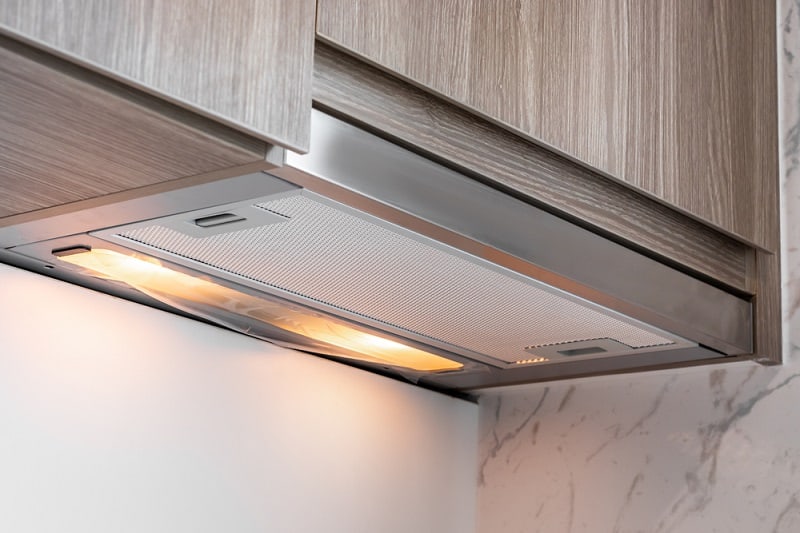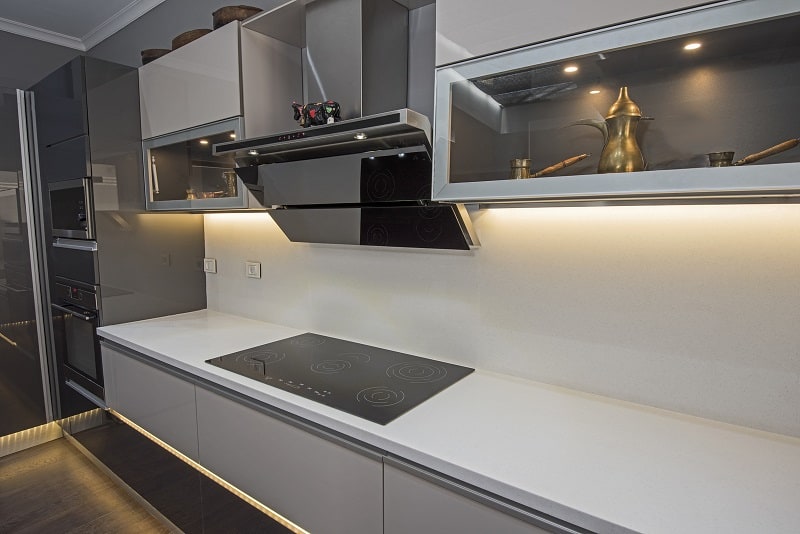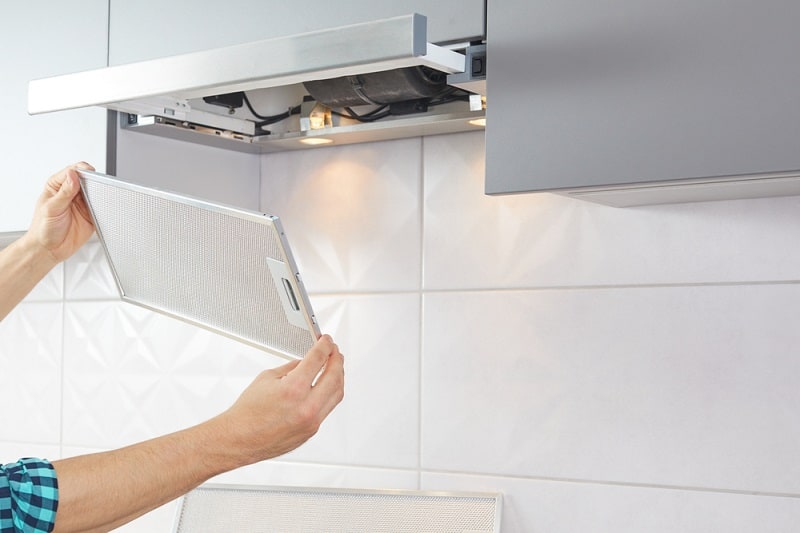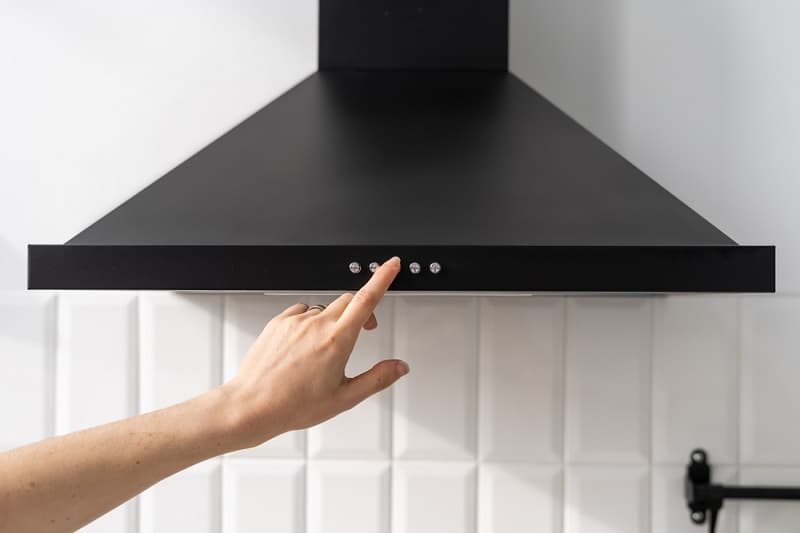Your kitchen extractor fan might not be the star of your kitchen, but it plays an important role in keeping your cooking space clean and smelling fresh.
When it’s working correctly, it quietly removes cooking odours, excess moisture, and grease from the air. But how can you check if it’s doing its job?
Here, we show you how to check if your kitchen extractor fan is working as it should. We’ll explain the common signs that indicate a problem, such as weak airflow or strange noises, and provide easy steps to figure out what’s going on.
If there is an issue, don’t worry—we also have a step-by-step guide on fixing your kitchen exhaust fan.
How to Tell If Your Kitchen Extractor Fan Is Working Correctly
To determine if your kitchen extractor fan is working correctly and removing grease, steam, and odours as you cook, ask yourself the following three questions:
1. Does your kitchen extractor fan turn on?
The first thing you should do is to try and turn your kitchen extractor fan on—an extractor that doesn’t turn on is definitely broken!
All exhausts and range hoods function differently but can be divided into two main design categories:
- Manual control: You may need to press a power button, turn a knob, or use a touchpad to activate the ventilation system. This will start the fans that draw air and cooking odours through the filters.
- Automatic ventilation: Other kitchen extraction fans turn on automatically when they sense a certain amount of heat from your stove. If this is the case, you’ll need to test the extraction fan’s functionality when you’re next cooking.
It’s also wise to test the fan at different speeds. Most extractors have multiple fan speed settings (low, medium, high), allowing you to choose the appropriate speed depending on the amount of cooking and the level of ventilation needed.
Check that the pulling from your fan increases as you move up the different settings by holding a tissue in front of the fan and observing its movement.
Often, people experiencing issues with the extraction fan in their kitchen have a fully functional fan but aren’t using these settings properly.
Make sure you’re choosing the right level of ventilation, or the exhaust won’t be able to properly remove all steam and grease from the air as you cook.

2. Is your kitchen extractor fan making loud noises?
Another sure sign that your kitchen exhaust doesn’t work is if it’s making loud noises. A little noise from the fan is expected, but excessive noise can indicate something is wrong.
In general, a kitchen exhaust fan is considered quiet if it produces noise levels within the following guidelines:
-
- Low speed: At low speed, a quiet kitchen exhaust fan should produce noise at around 40 to 50 decibels (dB). This is roughly equivalent to the sound of a refrigerator running.
- Medium speed: At medium speed, the noise level might increase to around 50 to 60 dB, which is comparable to the volume of a normal conversation.
- High speed: A kitchen extractor fan might generate noise between 60 to 70 dB when running at its highest setting. This is similar to the sound of a vacuum cleaner.
Remember, all models are different, and the most powerful cooker hoods will likely make more noise than this.
However, if your kitchen exhaust is making excessive sounds or unusual noises (such as rattling, banging, humming, squeaking, or grinding), there is likely a problem.
Some of the most common issues that cause a noisy kitchen extractor fan include:
- Loose or damaged fan blades, motor mounts, or bolts.
- Dirty or clogged filters that obstruct airflow.
- An accumulation of grease in the fan and air ducts.
- Motor issues, such as worn-out bearings.
- Loose housing around the kitchen exhaust fan.

3. Are there signs of grease buildup or steam damage?
The job of your kitchen exhaust is to pull steam and grease from the air as you cook. If there are signs of grease buildup or steam damage, it’s a sign that your kitchen extractor fan isn’t working. Here are some common signs to look for.
Signs of grease buildup:
- Look for greasy or sticky surfaces on kitchen cabinets, walls, and countertops. Grease buildup can accumulate on any surface near the cooking area.
- Over time, grease and cooking residue can mix with dust in the air and form a sticky, dusty layer on cabinet surfaces.
- If you have an over-the-range hood with filters, check the filters for a buildup of grease and cooking residue. These filters should be cleaned or replaced regularly.
- Handles and knobs on kitchen appliances, cabinet doors, and drawers can become sticky or grimy due to grease buildup.
- Grease and oil can leave behind stains and discolouration on surfaces in your kitchen, making them appear dull or dirty.
Signs of steam damage:
- Excessive moisture from steam can impact the paint or wallpaper in your kitchen, causing it to peel or bubble on walls and ceilings.
- Condensation on windows and walls can indicate high humidity and steam in the kitchen.
- Prolonged exposure to steam and moisture can lead to the growth of mould and mildew on walls, grout, and caulking in the kitchen.
- The presence of mould or mildew can lead to musty or unpleasant odours in the kitchen.
- Wood surfaces, such as cabinet doors or wooden furniture, can warp or swell when exposed to excessive steam and moisture.

How to Fix a Broken Kitchen Extractor Fan
Having asked yourself the above three questions, you should know whether your kitchen extractor fan is working. Common signs of a broken fan include:
- Weak or no airflow from the extractor fan.
- Unusual or loud noises (some slight noise is expected).
- Inadequate removal of condensation and cooking odours.
- Excessive grease buildup in your kitchen.
Cooker hoods are necessary, so you should prioritise fixing the issue. This may require some basic troubleshooting and, in some cases, professional assistance.
Here are the steps you can take to address common issues with a broken kitchen extractor fan:
- Check power and controls – If your exhaust doesn’t turn on, ensure that the extractor fan is receiving power. Check the power source, such as the outlet or circuit breaker, to make sure it’s not the source of the problem.
- Inspect the filters – If your extractor fan has filters, inspect them for dirt, grease, or clogs. Dirty or clogged filters can reduce the fan’s efficiency. Clean or replace the filters as needed—regularly changing cooker hood filters is essential for proper operation.
- Clear obstructions – Check the fan and ductwork for obstructions blocking airflow. Remove any debris, dust, or items that obstruct the path of the air, and clean the interior of the fan and the surrounding areas to remove accumulated grease and dirt.
- Inspect the exhaust vent – Ensure the exhaust vent is properly connected and unobstructed. Sometimes, the issue may be outside the kitchen, where the vent leads to the exterior. Check the vent cap or flap outside for any obstructions or damage.
- Check the fan motor – If your kitchen range hood makes unusual noises or the fan doesn’t turn on, it may be a motor issue. The motor may need to be repaired or replaced. This is a task best left to a professional technician.
If you’ve tried the above steps and the fan is still not functioning correctly, or if you suspect a more complex issue with the motor, wiring, or control system, it’s advisable to consult a professional appliance repair technician or an HVAC specialist. They can diagnose and repair the fan effectively.
If the fan is very old and extensively damaged, replacing it with a new kitchen extractor fan may be more cost-effective. Newer models are often more energy-efficient and come with updated features.
You can read our guide on fitting your new cooker hood or learn about the cost of professional cooker hood installation.

Hannah is a freelance content writer and self-proclaimed foodie. When Hannah isn’t sitting tapping at her laptop, you’ll probably find her in the kitchen. As an ex-chalet host, she’s used to cooking four-course meals for 10+ people and loves feeding friends and family whenever possible.







